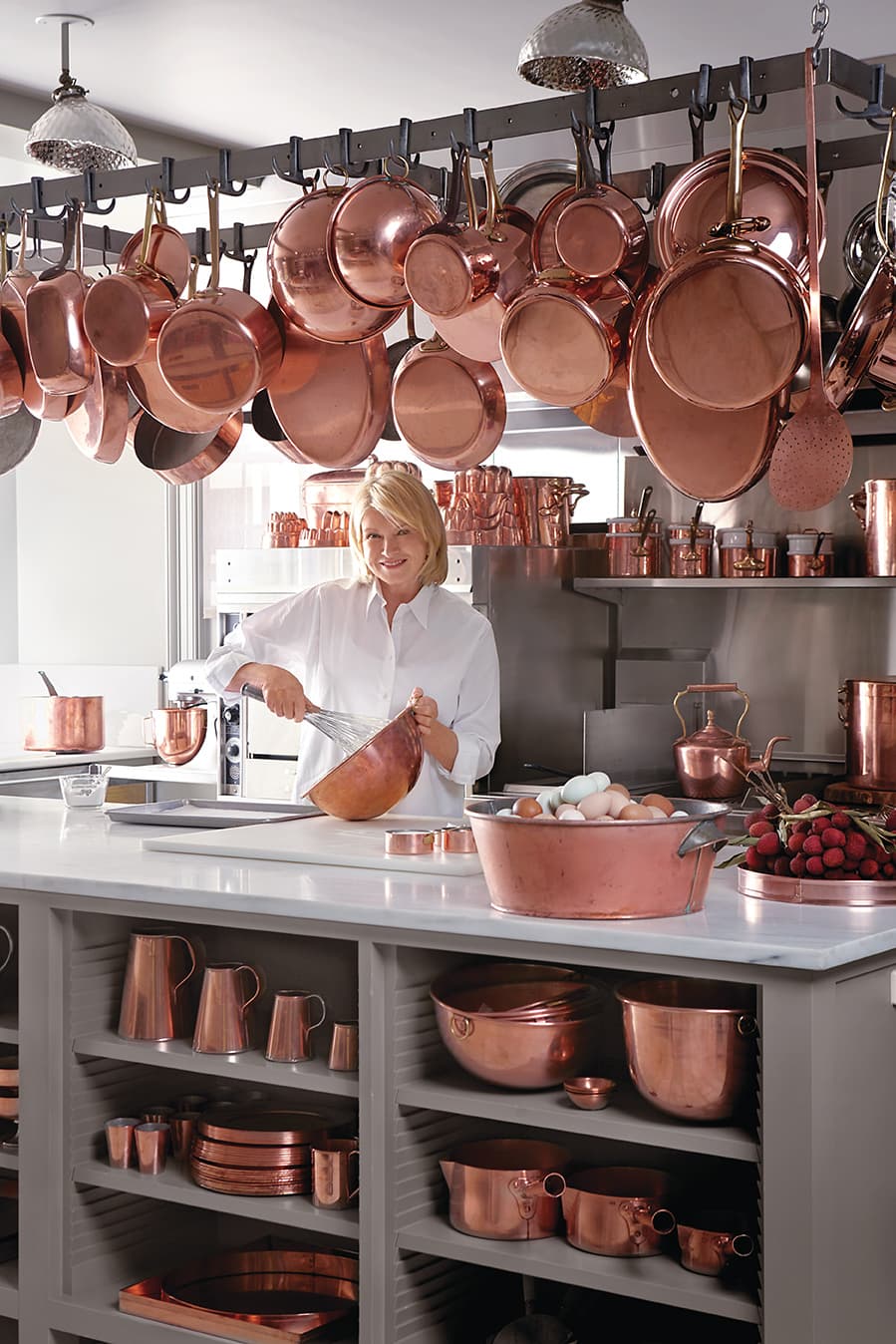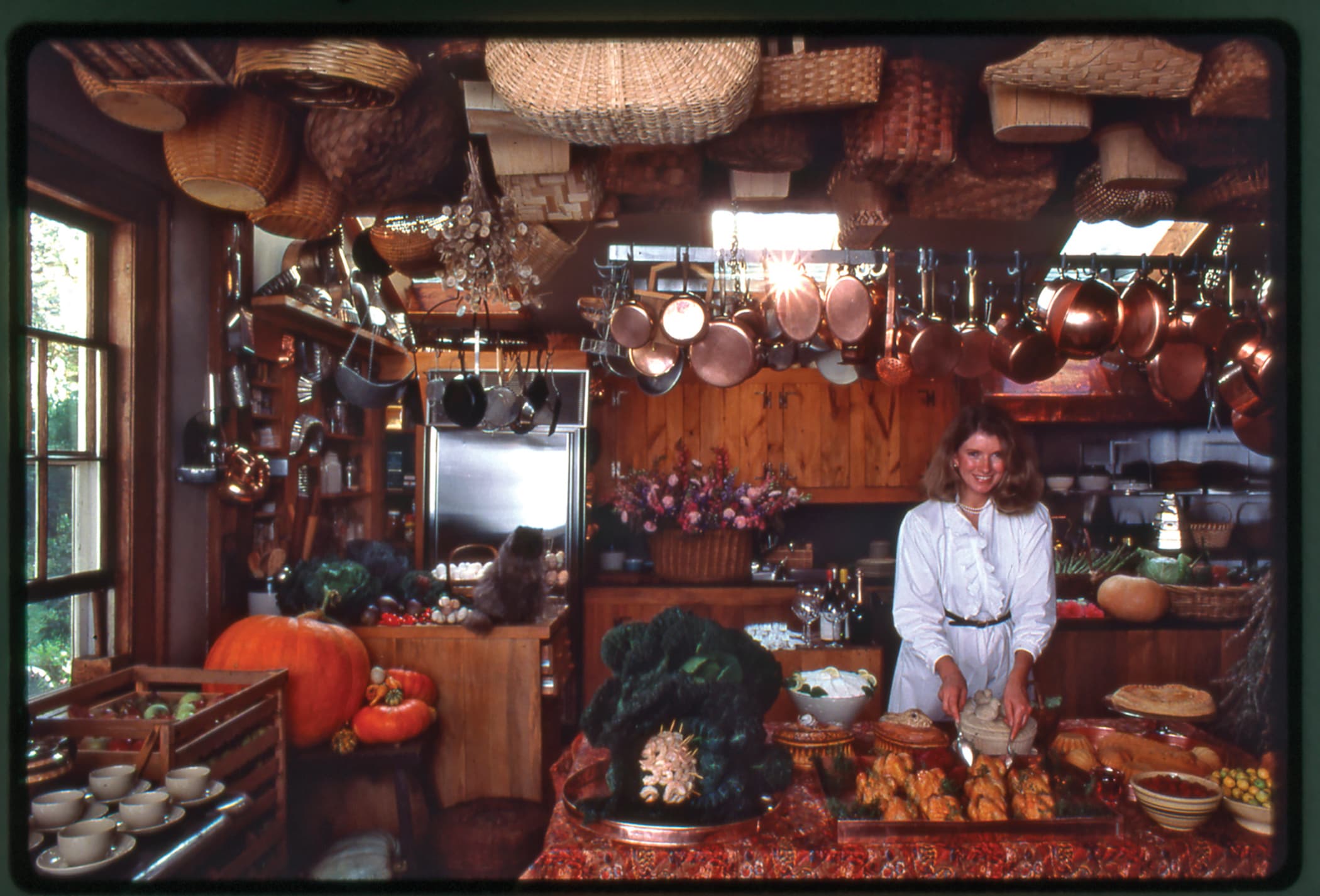Martha Stewart might spend more time in her kitchen than anyone we know. So we had her friend and brand guru William Li ask the Doyenne of Domesticity to divulge what she’s learned about designing them over the years, why function should always come first, and how to make the fluffiest scramble eggs you’ll ever eat.

Stewart in her kitchen, which holds an enviable array of copper cookware.
WILLIAM LI: So, Martha, since we’re talking about your kitchens today, what do you think are the key ingredients to a successful home kitchen?
MARTHA STEWART: First of all, take as much space as you can from the rest of the house. Space is important, no matter what. All my kitchens have the same basic design—I call it the subway kitchen or the railroad kitchen. The workspace is divided with an island, there is a wall of stoves, a washup area and then a seating area and maybe an additional, more comfortable seating area.
So really, it’s all about zones…
Yes, I like dividing it into zones, but again, it’s all about space. I want a large, airy, light—sunlit, if possible—windowed kitchen. And I like windows that open. I like ventilation. I like doorways to the outside so that you can bring things in from the garden to use while cooking.
Do you have pot racks in every kitchen? Is that a signature Martha thing?
Pretty much! I like the accessibility of the hanging pots. You can see what you have and which pot you need for the specific job at hand, and grab it. It’s very hard to use an under-counter space to store pots because they have to be stacked and they’re in small areas and then you have to take everything out to get what you need. I’m also a big fan of open shallow shelving near the work area. Everything is within reach and nothing gets lost.
How has your cooking style changed over the years, from when you were at Turkey Hill in Westport and knee-deep in that catering business to now, and how has the kitchen reflected that?
At Turkey Hill, I was just beginning my writing career, thinking about my first book Entertaining and collecting recipes from everywhere. I was an avid cookbook reader and experimenter. I was the original Julie to Julia Child. I cooked every single recipe in Mastering the Art of French Cooking. I actually built the cupboards at Turkey Hill myself! They were made from a sycamore tree that had fallen down on the property. And while it’s a very beautiful wood, it’s also very unstable, so the doors eventually warped and cracked. I learned to use poplar going forward for that very reason. But you can see that in many ways that Turkey Hill kitchen doesn’t look so terribly different from the more recent Bedford kitchen.
No, they look quite similar, actually.
I loved the baskets hanging from the ceiling. It was a rustic house built in 1805 and we didn’t do much to take away the feel of the early American architecture other than add the skylights. It had a big fireplace, which made it so cozy that we ate in there all the time. But I’ve since found I need a really big chef’s stove. That kitchen had a big Garland range in it originally, and then we put in an Aga, which was a mistake.
That’s hard to cook with, isn’t it?
An Aga is silly for an American kitchen because you have to turn it off in the summertime when it gets hot. But a big Garland was the appropriate stove for that particular kitchen. I really did cook dinner every single night there. And I also made a lot of preserves from the huge garden. You can see in that picture all that produce—the cabbages, pumpkins—everything was right out of the garden.

Circa 1982 in her first, Entertaining-era kitchen, in Westport, CT. MICHAEL SKOTT PHOTOGRAPHY
Is there anything you miss about your Turkey Hill kitchen?
Maybe the fireplace and the Dutch oven, which I actually did use to cook things. We made pizzas and bread, we roasted vegetables. I did a lot of baking in that kitchen. We also transformed the property’s carriage house into a very big outdoor catering kitchen, which I loved.
Do you have an outdoor kitchen now in Bedford?
Oh yes, definitely.
What’s the best setup for an outdoor kitchen?
It has to be very utilitarian. The one I have in Bedford has a huge freezer and refrigerator, three stoves, a workspace and a long open pantry with all the ingredients. If I don’t have something in the farmhouse kitchen—evaporated or condensed milk, say—I go straight outside and it’s there. We keep that pantry thoroughly stocked.
What would you say are the biggest differences between your original Turkey Hill kitchen and your current Bedford kitchen, and what are the biggest things they have in common?
The appearances of both are quite similar—the copper, the pots, the ability to grab things easily and cook. But the newness and the efficiency of the Bedford kitchen really set it apart from Turkey Hill. I put the best appliances in the Bedford kitchen and I can make pretty much anything there.
What’s your favorite appliance in the new kitchen?
I would say it’s the stoves, and my professional San Marco cappuccino machine, which I also use to scramble my eggs—you put eggs in a cup or bowl with a tiny bit of butter and a dash of salt and steam them with the milk steamer. In about 30 seconds you have beautiful, fluffy eggs.
I love that. Asians steam their eggs quite a bit.
I learned how to steam eggs like that from Buvette in the West Village. They didn’t have a stove top, so they made their eggs with the cappuccino machine. Sant Ambroeus does the same thing. Those beautiful fluffy scrambled eggs they have on the sandwiches? Oh my gosh, those are all steam.
Talk to me about decorating in the kitchen. I notice all the copper in both these kitchens, and that’s very decorative. But what’s your feeling on other ways to combine decoration and function?
The copper isn’t just there for decoration, we definitely use it. But it’s also important that it looks good, so every pot is polished before it’s hung back up. I also change the look of the kitchen by swapping out the plates, cups and saucers stacked on open shelves. I do not believe in big upholstered chairs in the kitchen—we’ve always used stools or wooden chairs. I like things that are easy to clean and wipe up.
Do you have a favorite paint color, or a favorite tile, or any materials you return to again and again?
The Bedford kitchen is a color called Bedford Gray with white marble counters and countertops and backsplashes. The floors are old white marble that I excavated from a house that I bought out in East Hampton. It originally belonged to the architect Gordon Bunshaft, and in the garden there were these big marble pavers that had been in the ground since he built the house in the 1960s. I had them dug up, sliced horizontally and used the dirty side for the kitchen floor in Bedford. The stone guys thought I was crazy! They couldn’t understand why I wasn’t using the nice clean white side, but it looks fabulous.
Do you always use marble for counters? Is that your counter of choice?
I’ve used marble, I’ve used soapstone. I did use wood originally for my outdoor working kitchen, but I don’t like wood as a countertop as much as I like stone. It’s much easier to clean. I also love zinc. Up at my home in Maine, all my counters are covered in zinc. It’s actually the baker’s choice because you can roll out dough on it without using extra flour and it won’t stick.
What’s your least favorite kitchen design trend?
Fancy-schmancy. Kitchens are workspaces! Practicality above all else. Save up your money to buy the best oven that you can afford because having a really, really good oven is so essential to being successful in the kitchen. But there are ways to make practical look beautiful. I like to mix old and new. A lot of things in my kitchen are old, but I like the look of that. That’s why I loved having those baskets on the ceiling in Turkey Hill.
You’ve done a lot of travel. You’ve been to a lot of beautiful homes. Has there been one kitchen that you’ve walked into and you’ve said to yourself, “Oh my God, I wish this was my kitchen.”
I love restaurant kitchens where the action is happening. Go into Daniel Boulud’s kitchen at Restaurant Daniel—now that’s a kitchen. Or Nathan Myhrvold’s personal kitchen. He did the huge five volume The Way to Cook cookbook and was the chief scientist at Microsoft. His kitchen has a machine that freezes everything in five seconds and one that thaws everything in 10 seconds. He made me buy a centrifuge, and now I use it to make pea butter. All kinds of crazy stuff goes on in there! It’s futuristic, but I love stuff like that. Even the home cook can make exciting things happen.
















